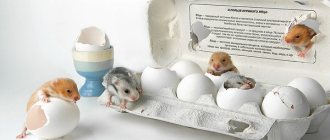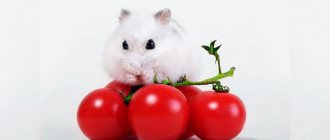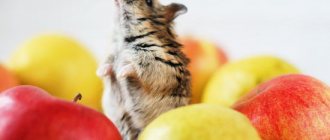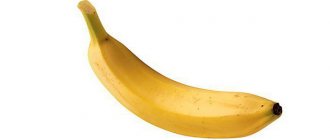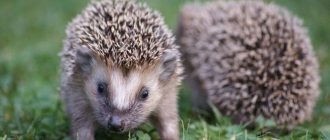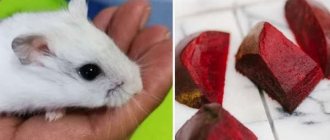Is it possible to give a decorative rat tangerine and orange?
To begin with, it is worth noting that these 2 citrus fruits are the most allergenic of the entire family, and therefore you need to be careful with them. They are undesirable in the diet of rats. In addition to the fact that the animal may be allergic to them, they are also dangerous because they can cause ulcerative lesions of the stomach and intestines. Like people, there are rats that love citrus fruits and are not allergic.
A rat eats a tangerine. In this case, you can give this delicacy to rodents from time to time, but in very small quantities. If you decide to try giving your rat a tangerine or orange, then you should do this without giving large pieces at once, but starting with small portions. In this case, you need to carefully monitor what reaction your pet will have.
Article on the topic: Can rats have cheese, milk, cottage cheese and other dairy products?
What should you remember when feeding your pet rodent?
First of all, it is worth understanding the difference between a domestic rat and a street gray “beast”. Representatives of the second species are dangerous to humans. They are carriers of diseases and are omnivores. Each homeowner, independently or with the help of special services, tries to eliminate street rats. But a pet has many differences:
- a clean animal and does not spread pathogens;
- smaller in size;
- afraid of drafts and prone to colds;
- not considered omnivorous.
Decorative rats are not carriers of infections and are very clean
All these facts point to special care and ways of creating a rodent’s diet.
Feeding a pet rat
Any type of rat at home should have a balanced diet. It should include vitamins, cereals, fresh vegetables and fruits, and cereals. Don't forget about chalk and branches of fruit trees. These two products help sharpen your teeth and at the same time clean them. Rusks and cabbage rolls are an excellent way not only to refresh yourself, but also to strengthen the tooth enamel of a rodent. But you shouldn’t overfeed either.
Special feeds containing various cereal crops are sold
Let's move on to gastronomic preferences. All types of rats love cheese. But you shouldn’t give them in large quantities. The intestines can quickly become clogged and the pet will have problems with its functioning. Variety is good, but you should understand that animals are small and frequent changes in food lead to problems with digestion and liver function.
Feeding a pregnant rat
Like any pregnant woman, a decorative rat needs increased nutrition and a large amount of useful and necessary vitamins and minerals. The diet immediately includes boiled poultry and fish. Cartilage from chicken bones is suitable. Vegetables and fruits – apples. Can rats eat grapes in this position? Grapes are always useful. But in order for the female to give birth well, and the pups not to be too large, the grapes are limited to a minimum. At the same time, completely exclude the seeds from the grapes. Liver, fresh wheat grass and broccoli also fall under minimalism.
The first half of pregnancy is the most important for bearing. Therefore, experts strongly recommend not to overfeed your pet, but instead of feeding it twice a day three times a day. Tomatoes and onions become dangerous.
The second half of pregnancy provides an opportunity to increase the female’s diet. Now you can include in the menu in addition to meat and fish:
- cottage cheese and apples;
- nettle and cartilage;
- porridge.
Rats can eat apples in small quantities
The same foods and grapes fall under the taboo. All types of seeds and cucumbers. Even raisins are completely prohibited.
Feeding a newborn rat
After giving birth, females become aggressive, as they must protect their offspring. But aggression will not affect nutrition in any way. It must be complete and balanced. In fact, we continue to feed exactly as during pregnancy. But now it is necessary to provide a large amount of liquid. Be sure to add cheeses and milk to the menu. But bananas, grapes and persimmons remain taboo. But can rats have persimmons to pamper them? In no case. The fruit is poorly digested and does not allow normal excretion of feces.
Need to know! It is important for all species and ages of the rat family to have protein food daily. If there is an insufficient amount of the necessary substances, namely protein, individuals begin to get sick. As for small rats, the deficiency will lead to weakened immunity, underdevelopment of bone and muscle tissue.
Feeding small rodents
Until a month of life, the mother provides nutrition and all the necessary substances for the development of the cubs. Complementary feeding or a complete transition to adult food occurs every month. From this moment on, the small animal should receive meat, fish and cottage cheese. Apples and corn (young). The list of forbidden foods included: lettuce, cucumber, tomato, mushrooms, yolk and, of course, broccoli.
The mother will provide food for the first month of life for the rat pups.
Is it possible to feed a rat fruit seeds and peels?
A small amount of citrus fruit pulp in a rat's diet provides it with essential vitamins, but what about the seeds and peel? They can be given quite a lot of different fruits; however, cherries, plums, apples, rowan berries, pears, persimmons, apricots and peaches should be pitted first. These bones contain hydrocyanic acid, which can cause poisoning of the animal.
Rat and orange Even one seed contains enough of this acid to bring the animal to death. Orange and tangerine seeds should also not be given. In general, you should forget about this; for all fruits, it is better to give some ripe and fresh pulp if you do not want health problems for your pet. You should not feed your pet the peel; it is preferable to always try to peel the fruit from it and give only the best pieces.
Vitamins and supplements
For growth and development, rodents need vitamins and microelements. If the animal’s nutrition is complete, then the pets do not need additional sources of nutrients. Rat food manufacturers try to include all kinds of vitamins and additives in their products. Lack and insufficient intake of nutrients causes vitamin deficiency, rickets, osteoporosis, muscle weakness and other health problems.
To prevent diseases, the animal’s diet includes supplements containing microelements necessary for development:
- Sodium is found in rock salt and fishmeal.
- Phosphorus - in liver, sea fish and milk.
- Calcium is found in bone meal, chalk and slaked lime.
- Potassium is in table salt.
- Magnesium is present in salts and green feeds.
- Sulfur is found in dairy products.
- Iron is found in greens, wheat bran and yeast.
The rodent body needs minerals in small quantities, otherwise they are not absorbed. For the correct balance of microelements, additives based on yeast, soy flour and animal feed have been specially developed.
Vitamins play a significant role in the development and formation of a pet’s bone tissue:
- A: responsible for growth and reproduction, found in milk, egg yolks, fish oil and carrots.
- D: for bone tissue and is present in fish oil and irradiated yeast.
- E: normalizes cell growth, is responsible for offspring. The presence is noted in the germs of sprouted wheat seeds, in corn and peas, in vegetable oils and lettuce leaves, in eggs and milk.
- B: responsible for liver function. Present in brewer's yeast and fish meal.
- B1: takes care of the nervous system. They are rich in bran, yeast, oats, and dairy products.
- B2: activates metabolic processes; found in yeast and sprouted grains.
- B3 (pantothenic acid): responsible for metabolism. Found in peas and beans, yeast and liver, egg yolk and fish roe.
- B12: promotes the growth of young animals. Source: fishmeal and shellfish meat.
- C: strengthens the immune system, is responsible for growth. The content was noted in fresh vegetables, fruits, and herbs.
- K: responsible for blood clotting. Present in hay and root crops.
For vitamin deficiency, veterinarians recommend synthetic vitamins and supplements, but this requires a precise approach to the dose of drugs. An incorrectly calculated dose of medicine leads to the death of the animal.
To prevent vitamin deficiency, supplement your pet’s menu with ready-made balanced food.
Other citruses in the life of rats
Above, we discussed only the two most allergenic citrus fruits as food for decorative rats, but the citrus family does not end with tangerines and oranges. All recommendations are given in the case when the pet does not have allergies and the animal tolerates citrus fruits well.
Grapefruit
The pulp can be given from time to time in small quantities. The main thing is not to overdo it, as it contains a lot of acid.
Lemons and limes
You can give a small piece, very rarely. Bones and seeds should not be given because they contain the glycoside amygdalin, which, when decomposed, forms poisonous hydrocyanic acid.
Rat and lemon
Pomelo
Give only the pulp in small quantities, as it increases acidity. Pomelo peel is a carcinogen for rats, especially for males.
Sweetie
Sweetie, also known as pomelo, is essentially a hybrid of pomelo and white grapefruit. However, it has practically no seeds; you can give it a little pulp.
Article on the topic: What to feed your pet rat: what it eats and what food it likes most
Boiled eggs in rat diet
Here we come to our topic: eggs are an excellent source of protein. With the correct use of boiled eggs in the animal’s diet, there will be no problems, given that such a delicacy will definitely be to their taste and benefit, but it is important to remember the following:
- adult rats should not be fed more than once a week;
- your pet may choke on the yolk, so it should be diluted with water;
- an allergic reaction is not uncommon, so for the first time you do not need to give the rat much, and after feeding, make sure that no spots have appeared, and the animal is active and cheerful, as always;
- eggs are high in calories and can lead to obesity, so you should not abuse them;
- domestic rats should not be fed dishes with eggs from the table, as they may contain oil, salt or spices;
- Rodents cannot eat fried foods, so treating your animal to scrambled eggs is not a good idea.
Raw eggs: is there a danger?
Thanks to wild rats (and their raids on chicken coops), there's a stereotype that raw chicken eggs are safe for pets, but the truth is that pets don't need extra protein because they already get it from their food. In addition, they may contain worms and other parasites, which can linger in your animal’s body for a long time and lead to dire consequences.
From the point of view of parasites, quail eggs are safe, since the temperature of quails is about 40 degrees and salmonellosis cannot develop. They can be given no more than once every two weeks with a serving of no more than a teaspoon.
Fermented milk products for stable digestion
Fermented milk products can harm your tailed friend only if the pet has individual lactose intolerance. It is rare, but still, when you try to give milk for the first time, you should not overuse it, as the consequences may include intestinal upset, severe diarrhea, etc. If an allergy is detected, your pet can be treated to lactose-free foods.
What can you give from dairy products?
If there is no allergy, foods without additives (dyes, berries, etc.) with a small percentage of fat content (but not low-fat) should be given.
Therefore, without flavoring additives, your pet can be treated to natural yogurt, kefir, fermented baked milk and cottage cheese, but in small quantities.
Due to the fat content and too high calorie content, you cannot: cheese, sour cream, cream, dried milk (regular milk - with caution)
How can you tell if a rat is allergic to citrus fruits?
If, after you give your pet a piece of any citrus, he experiences the symptoms described below, then this may be a sign of an allergy:
- swelling of the rat's paws;
- itching;
- irritation;
- rash;
- the appearance of scabs.
Rat with orange
In this case, you should contact your veterinarian. With proper care, allergies in rats can be treated quite easily and quickly, usually taking about 10 days. If the animal's paws are swollen, then they are treated with an antiseptic; this is also done if the eyes and ears are inflamed. During treatment, it is advisable to completely remove fruit from the rat’s diet.
In conclusion, we can say that you need to be extremely careful with citrus fruits and seeds; if you give permitted citrus fruits from the list, then only very rarely and in small quantities. Unfortunately, identifying an allergy in an animal to a particular product is often only possible through trial and error, but the main thing is to continue to care for your pet properly and do everything so that it does not have such a problem again. Citrus fruits can be safely replaced with other healthy and safe fruits and vegetables.
Other Features
From time to time you need to pamper your pets with treats; you can also use them as encouragement when training the animals. Walnuts, premium dry dog food, and fruit and honey sticks are considered healthy treats.
You can’t give sweets, chocolate, store-bought crackers and chips with a lot of salt, preservatives, soft fresh bread, smoked meats, unripe fruits, raw potatoes, radishes, turnips, beans, cabbage, peas, rhubarb, beans as treats, because they lead to increased gas formation, as a result the animals will have a stomach ache and may develop diarrhea.
It is worth keeping animals away from some house plants, since seemingly harmless greenery is poisonous to them. Prohibited plants include aloe, tulips, daffodils, fern, geranium, lily of the valley, plush, agave, kalanchoe, and horse chestnut. These plants are often found in the homes of owners, delighting with their beautiful appearance and fresh aroma, but in fact they are poison for baby rats and adult animals.
Rat
Vegetables for your hamster
Fresh vegetables are very welcome in the rodent's diet. As a rule, they are given every other day (less often for Campbell hamsters). It is a good source of organic acids, pectin, and other nutrients. They also supply the body with water, which is important for every living creature. Popular foods for hamsters are:
- beets - offered fresh and boiled;
- cucumber (only in season) – dietary, even Campbells are allowed once every 3 days;
- zucchini – useful for water balance, sometimes steamed;
- sweet peppers – without seeds, the peel is removed from the store-bought product;
- carrots - given raw or boiled, Campbells are allowed only tops;
- squash is a dietary vegetable, suitable for all breeds;
- pumpkin is low in calories and very healthy when eaten fresh.
Article on the topic: Can a rat have a boiled and raw egg (white and yolk)
There is a lot of other information about what vegetables can be given to hamsters. So, occasionally you are allowed to pamper your small pet with a piece of radish, turnip, celery, or cauliflower. Boiled without salt or fresh corn is useful; in moderation it is recommended for everyone except the Campbells. Peas and beans are sources of protein.
Should you give your pets raw eggs?
Wild rats often raid chicken coops in the hope of profiting not only from bird food, but also from their favorite delicacy - chicken eggs. For the same purpose, animals often steal the nests of sparrows or pigeons. Indeed, for tailed animals forced to survive in harsh conditions, this product is a valuable source of protein and vitamins.
But, unlike their wild relatives, ornamental rodents do not need additional protein, as they receive all the necessary microelements and vitamins from food, which is made taking into account the needs of these animals. Therefore, feeding small pets raw chicken eggs is undesirable, and sometimes even harmful. The fact is that they sometimes contain larvae of parasites, for example, worms, and animals after such a treat can become infected with them, which will lead to long-term treatment.
As an exception, you can pamper your pet with a raw quail egg. This treat should be given to your rat no more than once every two weeks. The portion should not exceed half a teaspoon.
If your pet likes to eat a boiled or raw egg, you should not deny him this pleasure, because if consumed in moderation, this product will become a tasty and healthy addition to his diet.
Is it possible to give eggs to pet rats 5 (100%) 2 votes
Fruits for your hamster
Hamsters can be given various fruits (with the exception of citrus and exotic ones), but in small doses. The high sugar content makes this complementary food unsafe. Domestic Djungarians are given less of it than individuals of the Syrian breed - within 5% of the main diet. Campbell's hamsters are fed even more carefully.
The main fruit products that are suitable for Syrian and Djungarian hamsters include:
- apple - choose sweet and sour varieties, introduce them from 4 months, do not give to lactating females;
- apricot – a little and not overripe, it is better to give dried apricots out of season;
- peach is better than nectarine, it has less sugar;
- pear – firm yellow or green, uncommon;
- banana – preferably a little greenish, just unripe;
- plum - a little at a time, so as not to provoke diarrhea;
- melon – due to excessive sweetness, allowed only once every 5-7 days;
- watermelon - also rare, but from your own garden (it’s hard to find a store-bought one without nitrates).
Berries will help diversify your diet. Strawberries are offered once every 7 days, a piece with a diameter of 1 cm. The rest of the berries from the list are given 1 piece per week, the portion for the Syrian hamster is doubled. Allowed:
- cherries and sweet cherries (pits removed);
- currant;
- not sour gooseberries;
- grape;
- raspberries;
- blueberry;
- blackberry;
- cowberry;
- blueberry.
Of all of the above, only dietary fruits are suitable for Campbell's hamsters. These are nectarine, blueberry, lingonberry, cherry, hawthorn. It is worth remembering that exotic fruits (mango, avocado, kiwi, pineapple and others) are prohibited from being offered to all rodents. They can cause severe allergic reactions and digestive problems.
Article on the topic: Can a rat have a boiled and raw egg (white and yolk)
Milk products
All dairy products will be beneficial to your rat's health, but it is important to be aware of the possibility of a lactose allergy. It is advisable not to give pure milk, but other fermented milk can be given, but without fanaticism, you need to introduce new products little by little, observing the reaction. It is also undesirable to consume homemade sour cream/cream/cheese; often such products have a high fat content, which can cause digestive disorders.
Possible and useful:
Any fermented milk product should have no more fat than 4%. When it comes to low-fat products, it is advisable to choose non-perishable or children's dairy products.
Dried fruits for hamsters
In winter, instead of not very healthy fresh fruits from the store, it is better to occasionally give your hamster dried fruits, but also in dosed doses. Such treats are often offered as treats and rewards during training. Ideally, of course, prepare them yourself using a special dryer or oven. The raw materials should not be too sweet - apples, pears, viburnum, cranberries, lingonberries.
It is worth considering the characteristics of the pet and its predisposition to diabetes. So, in the diet of the Campbell breed they often do without dried fruits; the Djungarian hamster is given less sweet treats, for example, apple slices. Syrian hamster and other species can be given raisins, homemade banana chips and a small piece of prunes 1-2 times a week.
Feeding rats video
Other similar posts:
Sea kale is rich in iodine, just like human rats also need this element.
It is best to purchase dry seaweed at a pharmacy and add it to your main feed. A rodent may have problems with the thyroid gland if its diet lacks iodine. Additionally, you can use mineral stone with algae and seafood in your diet.
You can buy seaweed in the store. It is good to rinse off the brine in several waters and offer it to the animal. The rats definitely won't eat much. We remove the remains from the cage.
It is enough to give seaweed once a week. The dry one is pre-soaked in water and offered to the animal. Its taste is not the most delicious, so you can add it to cottage cheese, yogurt or baby food.
Remember, this is the same as vitamins for humans. It's not worth giving a lot. Dry seaweed is taken on the tip of a knife (1/6 tsp) and diluted in 1-2 drops of water.
If the animal does not want to eat, do not force it. Suggest at another time. Can be stored in the refrigerator.
Great article 4
Plant food
Fruits in syrup, compote berries, and jam should not be offered to rodents. Any preserved food is prohibited because it contains sugar and salt. Raw seasonal fruits are preferred for feeding. Some of them are placed in the cage boiled (zucchini, beets, carrots, pumpkin). The cooking time in this case is minimal. The water is not salted.
If fresh fruits and vegetables are purchased at the store, it is better to cut off the skin (it often contains pesticides). For home harvest, this step is not necessary. Plant foods, including those from your own garden, must be thoroughly washed. After all, harmful bacteria and helminth eggs may remain on its surface.
All fruits must be fresh, not chapped, and free of rot. The pits of cherries, apples, cherries, plums, and apricots must be removed. The hamster can be poisoned by them. If a pear, pepper or other delicacy is cut into several pieces, the remaining pieces are stored in the refrigerator for several days.
It is important to remember that excessive fruit feeding causes indigestion and increased gas formation in hamsters, and increases the risk of diabetes and obesity. In small quantities, fruits help strengthen the immune system, improve intestinal motility, and are involved in the prevention of many diseases.
Article on the topic: Review of the best food for rats (budget and premium options)
Benefits of succulent food for rats
Plant foods should be present in the rat's diet every day. The approximate amount of succulent food per pet per day is 30 grams, of which approximately 85% is vegetables, and 15% is fruits and berries. Plant foods have the following beneficial properties:
- Acts as an additional source of moisture. Everyone knows that without fluid normal metabolism is impossible. Sometimes active rodents can get carried away and ignore the drinker. In such situations, there is no need to worry if the animal has received a sufficient amount of succulent food. The moisture deficit will be restored in full. Fruits and vegetables are especially refreshing in the summer heat.
- Contains a large amount of fiber. Rats often suffer from problems with their digestive system. Coarse plant fibers help start the processes of food digestion and also increase intestinal motility, normalizing stool. Fiber also lowers cholesterol levels in the blood, preventing heart attack and stroke.
- It is a natural source of micro- and macroelements. Store-bought vitamin and mineral complexes are clearly inferior in quality to natural food containing sufficient amounts of vitamins and minerals. Daily consumption of succulent food significantly increases the immunity of rodents, protecting them from various diseases.
- Contains antioxidants that help destroy and remove carcinogenic substances from the body. This is especially true for rats, since decorative rodents are prone to the development of neoplasms, both benign and malignant.
- It has low calorie content and does not overload the stomach. Eating vegetables, fruits and berries is an excellent prevention of obesity in rats. Even simple sugars contained in plant foods are completely broken down in the body and do not harm the animal.
It is worth noting that the listed beneficial properties are characteristic only of seasonal berries, vegetables and fruits grown without the use of nitrates and other harmful additives. It is best if the succulent food for the rat was collected from your own garden plot.
Before offering your rat fruits and vegetables, it is recommended to peel the fruits. New products should be introduced gradually, observing the reaction of the fluffy.
Can hamsters have an orange?
Hamsters love to eat fruit and will not refuse an orange. But the fruit is harmful to the animal. Citrus fruits contain large amounts of citric and other organic acids and sugars that affect the health of your pet.
It is strictly forbidden to give orange to an animal for the following reasons:
- It contains vitamin C in large quantities; your pet may develop hypervitaminosis.
- Citric acid negatively affects the condition of tooth enamel, and rodents’ teeth are covered with it only on the outside.
- A high content of acids negatively affects the stomach, the mucous membrane is irritated, and this can lead to many diseases.
- Sugar can cause the development of diabetes; animals are very susceptible to this disease.
If you give your pet a small slice of citrus, it can cause irreversible consequences. The animal may begin to lose hair from an excess of vitamin C. Due to an upset stomach, it will refuse to eat and its stomach will swell. If you notice such symptoms, immediately take your hamster to the veterinarian.
Prohibited Products
For the most part, rats can be given regular food, but there are exceptions:
- Dry peanuts or beans - they contain substances that eliminate the beneficial properties of enzymes and vitamin A necessary for the body to process protein and starch, and can also cause blood cells to stick together;
- Green bananas - destroy enzymes responsible for the absorption of starch;
- Potato eyes and skins contain solanine, known for its toxic properties;
- Raw tofu – it contains many bacteria that are not found in cooked tofu;
- Orange juice - not suitable for consumption only by males, can weaken the kidneys;
- Apple seeds - they contain a low concentration of cyanide, which is dangerous for pets;
- Artichoke – inhibits protein processing in the rat's body;
- Beans - destroys enzymes and vitamin A;
- Beet tops - can cause ailments of the urinary system and provoke the formation of stones in the kidneys and bladder due to the large amount of oxalates;
- Chocolate – contains too much sugar.
Can hamsters eat tangerines?
Tangerines are citrus fruits containing acids and sugar. Can hamsters eat tangerines? Rodents are prohibited from any exotic fruits. You can’t give them to an animal for the same reasons: teeth deteriorate, problems with the stomach and intestines, hair loss.
All citrus fruits, without exception, including pomelo and lemon, are unsafe for the animal’s body. It’s better to treat your gourmand to a piece of apple or banana.
Green food
A caring owner needs to monitor the consumption of greens by a pet rat. List of prohibited green food:
- bugs and horseradish contain substances harmful to animals - essential mustard oils;
- sorrel spinach are a source of oxalic acid, which is dangerous for the pet’s body;
- You can’t feed rhubarb to animals, because it causes disruption of the gastrointestinal tract;
- seaweed has a high iodine content.
Can a hamster have nectarine?
Nectarine is a product that is harmless to the animal’s health, but there are restrictions on feeding it to hamsters. This is a fairly large fruit, like a peach, so don't feed them whole. Break off small pieces and watch your pet. The large bone is another reason not to give the whole nectarine; it will damage the animal’s teeth.
The nuances of feeding nectarine:
- Don't give treats more than two to three times a month.
- If the animal does not eat a piece, immediately remove it from the feeder. Nectarines spoil very quickly, and rotten fruit can poison an animal.
- Too sweet nectarine should not be given to dwarf hamsters; this type of hamster has a high risk of developing diabetes.
What should a rat cage look like?
The optimal home for a rat would be a cage made of metal rods with a tray. Rats can climb on the grates, they are well ventilated and allow you to observe what is happening around. The distance between the rods should be about 1.5-1.7 cm (or less). If the bars are too thin (2 cm or more), the baby rats will try to crawl between the bars. At best, the pet will simply run away, and at worst, it will get stuck and suffer.
Excuse me, do you have anything tasty for the poor little rat?
In addition to size, the configuration of the cell is important. A flat (low) cage is not an option. No matter how big it is, the animals will be bored in it. Guinea pigs or hamsters live in fields, and the rat world is more complex and varied. The cage should have several levels.
A real palace for rats
- Glass containers (jar, aquarium, terrarium)
- Plastic container/dune
- Small cage for mice or hamsters
It is better if the metal rods are painted. Then they will not oxidize from the caustic urine of animals, and there will be no stains on them.
“I’m sitting behind bars in a damp dungeon.” Painted rods are the best option for rats.
There are two types of cage trays: with and without a false bottom. The false bottom is designed like this: the animals run along the grate, the tray is located below. The mesh should be fine enough so that the rats do not fall through with their paws. But not too much - so that feces fall through.
- Rats are always clean;
- You can use any type of filler;
- The filler is not scattered around the cage;
- Convenient to clean.
- An unsuitable grid can cause damage and inflammation of the skin on the paws - pododermatitis;
- Potential possibility of injury (dislocations, fractures);
- Rats are deprived of the opportunity to rummage through the litter;
- If a rat drops a treat from its paws, it is lost forever.
Overall, using a plastic false bottom seems like a great idea to me. It can be partially covered to make the rats more comfortable, additionally put paper towels in the cage for the house and hang hammocks for sleeping.
The shelves are lined with soft fleece fabric: it is soft, dries quickly, and does not tangle your paws
What to feed decorative rats? Before answering this question, let’s define what they generally are. The colors of decorative rats can be completely different: from white to black and red. There are about 8 species of decorative rats:
- naked. They have no hair, with the exception of antennae;
- standard. These are the largest decorative rats that grow up to 800 grams. From these rodents the remaining species were bred;
- satin rat. It differs from others in its long and fluffy fur. Lives mainly in the USA and Western Europe;
- rex. Famous for its fluffy and curly fur;
- dumbo. A distinctive feature of these rodents is their ears, which are located lower than those of all others, and are not pointed in shape, but round. The body of these animals is shorter and more rounded than that of their relatives;
- tailless. What scares many people away from rats is their long, hairless tail. These ones don't have it at all. This feature makes them cute and almost hamster-like;
Litter for rats: which one is better?
The absence of “aroma” from a cage with rats is an important condition that allows you to calmly enjoy communication with your pets. Rat urine has a strong, unpleasant odor, and feces don't smell like roses either.
To prevent animals from getting dirty in their own excrement and to reduce unpleasant fumes, filler is used. You will have to select it through your own experiments, depending on the characteristics of your pets, cage and personal preferences. The main condition is that it must be safe for rats.
Paper fillers
In my time, rats lived without any fuss - on a thick layer of newspapers. The newspaper was replaced daily, which effectively controlled the odor. Nowadays it is not recommended to use newspapers due to the possible toxicity of the paint.
White paper napkins and towels would make great fillers, but they are too expensive. Rats drag the soft material into the houses and quickly chew it into small pieces. Paper napkins are warm, soft, not dusty. They do not cause allergies, respiratory problems, and do not damage the eyes and paws. They are used to furnish a maternity hospital.
An excellent everyday option is industrial paper (cellulose) filler. It is safe for the health of rodents and they really like it. It can be flushed down the toilet. No cons found. However, experienced owners say that if there are a lot of rats, an unpleasant smell appears quite quickly.
Wood fillers
The most common litter for rats is sawdust. He is also the most harmful.
- Dusty (cause inflammation of the eyes and respiratory tract);
- Pine sawdust irritates the respiratory tract due to essential oils.
The sawdust on the right (My Beast) is supposedly completely safe. But they are made of coniferous trees! The sawdust on the left (Triol) is deciduous.
Only sawdust from deciduous trees can be used and only if it is out of reach of rats (false bottom in a cage). But with this option, it is more convenient to use granular filler (pellets), which are cheap and effectively absorb moisture and odor. Wood pellets are not placed in the cage.
Only large shavings can be placed directly into the cage, since they do not generate dust.
Rats on a bed of shavings
Some rat breeders also use wood chips. You can buy it in a hypermarket or hardware store under the name “chips for smoking.” For smoking, hardwood trees are always used - alder, oak, cherry, beech. This is important for rats, many of which have a respiratory reaction to coniferous trees.
Corn filler
Fillers made from the core of corn cobs are quite good. Their advantages:
- Eliminates unpleasant odors well and absorbs liquid;
- Never causes respiratory diseases;
- Even if the rats eat the litter, it will not harm them.
The only caveat: if the corn filler is granular, you cannot put it directly into the cage. Hard granules damage rats' paws.
Prohibited litter for rats:
- Hay or straw;
- Flavored fillers;
- Bentonite clay;
- Silica gel;
- Office paper;
- Newspapers magazines.
